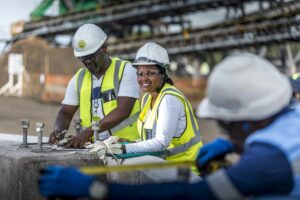| Biography Deepa Vallabh has over 22 years’ experience in corporate and commercial practice and has in-depth knowledge in a number of legal areas, including mergers and acquisitions (both domestic and cross-border), capital market transactions, BEE transactions, corporate reorganisations and restructurings with a particular focus on cross-border M&A transactions into Africa. Deepa has experience in a variety of sectors which includes mining and resources, technology, telecommunications, media and communications, FMCG, insurance, agriculture, manufacturing and private equity. |
What is your title at Hogan Lovells?
I am a partner in the corporate and commercial Mergers and Acquisitions (M&A) department.
Why is the convergence of technology and mining presenting legal challenges?
As technology progresses, a sector like mining can’t ignore the developments that are happening in technology and the ability which is being created for them to create efficiencies in their operations. There is a convergence between the technological sectors and the traditional mining sector. We ask questions about the legal intricacies surrounding technological innovations in mining operations and how they can be navigated. In the legal landscape, you’ve got two very different sectors which are regulated by very different pieces of law. When you integrate that effectively, mining companies have to become au fait with the rights and challenges around technology.
Would that include things like copyright on technology?
Correct. Depending on the kind of technology you are dealing with, it is external or internal. If it’s external, you generally have a supplier that has come up with a product and has created some technological or technical efficiencies which the mining operator can employ. Then the legal regime is one of a licensing arrangement to use the technology or to explore the technology and then a fee is payable. In those scenarios, the copyright sits with the licensor, which is the entity which has either developed it or has the ability to license that. The originator. They hold the intellectual property (IP) and they will have the registered rights to the IP. Where it becomes really interesting is when you have a piece of technology that needs to be adapted for a specific mining operation. If a certain technology measures something or works out where the resource is sitting, that technology might have to be adapted depending on the minerals you’re looking for and depending on the kinds of operations.
Would the climate be a variable?
Or even the climate, whether it is an underground operation or a surface operation. Often mining companies will engage with these technology companies to try to adapt the technology and then it becomes interesting from a legal perspective: who owns the amended technology or software?
So what sort of law do you go to there?
IP law has some basic principles. The registered owner owns the IP and they have a title and they have the ability to defend the title to that particular IP. However, the intricacies of these developments are in the commercial rig agreements that you put together so you can govern contractually how that IP is actually shared and if it is shared. This then depends on the rights of the licensor versus the licensee, the strength of the licensor versus the licensee. For example, a licensor like Microsoft is generally not going to be very amenable to giving you the IP even if they are developing a bespoke product for you, whereas a small technology player may feel they want the business.
They want the next contract?
They want the next contract, so they would maybe be more amendable on sharing the ownership structure of the IP. Those issues become very interesting. The additional challenge also is that sometimes you enter into these agreements and you put something in place for the licence but operationally when you are on the ground and you start adjusting the IP and nobody regulates this… it wasn’t in the contract, someone will say. Legal challenges arise from that if there is a dispute scenario. These are some of the things that mining companies and technology companies working with mining companies have to start thinking about.
And are you trying to help both parties navigate that before it becomes a problem?
Absolutely. There are certain things that we will ask upfront before the commencement of the negotiations or the drafting of the document. What is this IP about? Will it be developed? Is it changeable and who owns the developed IP? A lot of technology relating to what a mining company would be interested in relates to the IP and the adapting of the IP.
Is our legislation keeping up or is it still evolving with this merging of the two sectors?
With respect to IP legislation per see, there is obviously legislation that protects the ownership of the IP, and the rights of parties who have developed IP. You can register your IP and you can create a patent around your IP, you can have a natural copyright in things that you have created. The IP laws are not new, but they haven’t been adapted to deal with issues like who owns co-mingled IP for example. By that I mean IP that’s been developed collectively.
There is a body of jurisprudence around this and there’s a significant amount of case law that guides us but a lot depends on how you contractually create the framework.

Balancing technology and employment
Is there not a danger that new technologies will reduce employment?
There are other considerations that are really relevant in our South African market and in the context of an African market. Where you have efficiency technologies being introduced, mining companies have to balance the need to invest in these technologies with the need to balance the ability to keep people employed in a sector in an economy where jobs are so relevant. It is a big issue. The mining sector contributes a significant amount to the South African GDP and a significant portion of that mining sector is labour intensive. There is a significant population in South Africa that relies on that employment. I think the mining industry employs something like a half a million people across South Africa and the same issue applies in other African countries. Every developing country has the need to ensure that they are creating as many jobs as possible.
Is Hogan Lovells also in the business of advising on that kind of thing?
We would be able to advise on the employment issues around these aspects. From a legal perspective, we can navigate these issues depending on the client, but this is more of a commercial consideration for mining companies who are looking to invest in technology or put capex into technology. They’ve got to balance the need to keep people employed versus the need to be more technologically efficient.
In some markets, that need to keep people employed is actually legislated, isn’t it?
Correct and our market is one of them. You also have to think about the fact that a significant proportion of the workforce in the mining industry is unionised. It is a massive drive for the government to ensure that these jobs are available and that they are decent paying jobs and that the health and safety of workers are being taken care of. Mining companies have a slew of legislation and a raft of requirements to deal with in terms of ensuring that their people are safe because there are safety measures, health protocols and standards that are applied to wages and living conditions. These are all covered in our mining legislation and in our Labour Relations Act. You have to balance that with the need to be commercially profitable as a mining company; it may well be profitable to invest a chunk of capital in a machine that’s going to do the work of what a thousand employees are doing; it’s more efficient, you don’t have to pay medical aid, you don’t have to give severance, you don’t have to give housing. Balancing those needs in our market has to be taken into account, and that’s the challenge for most African governments and most African mining companies.
Do you have periodic workshops with senior mining executives that you might be consulting with?
We do and it depends on what’s topical at the time and what is relevant to our clients. We have a very sophisticated mining industry so these issues are not alien to the executive teams of these mining companies. They are constantly balancing that need to increase stakeholder value. In terms of our legislation, we’re supposed to be looking at the benefit for the stakeholder community and that stakeholder community includes employees, the communities within which you mine, your shareholders, of course, and it also includes the environment. The mining companies have a responsibility to look at these issues more holistically than just economically.
environment. The mining companies have a responsibility to look at these issues more holistically than just economically.
And you’re there to guide them, as it were?
Yes, we are there to guide them.










